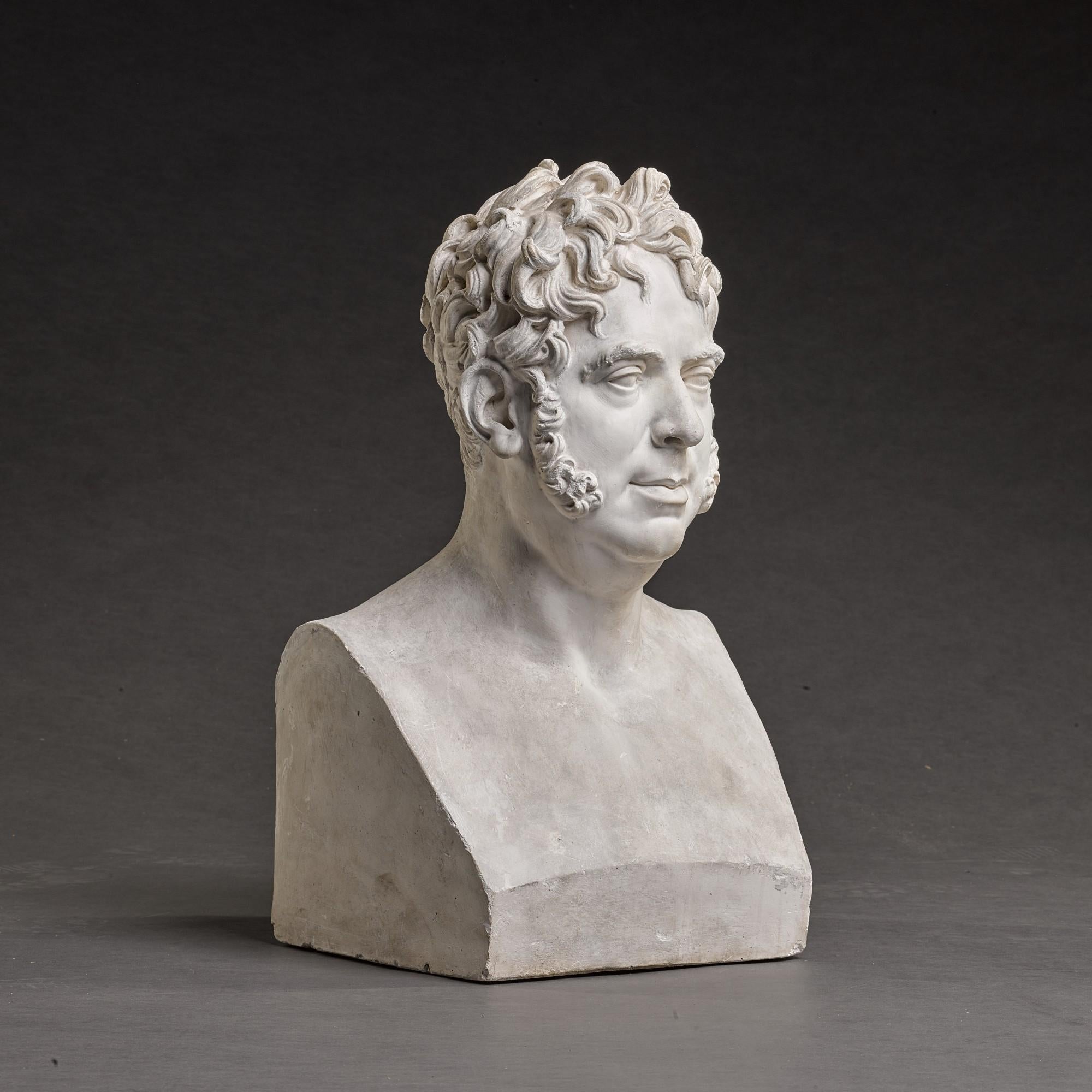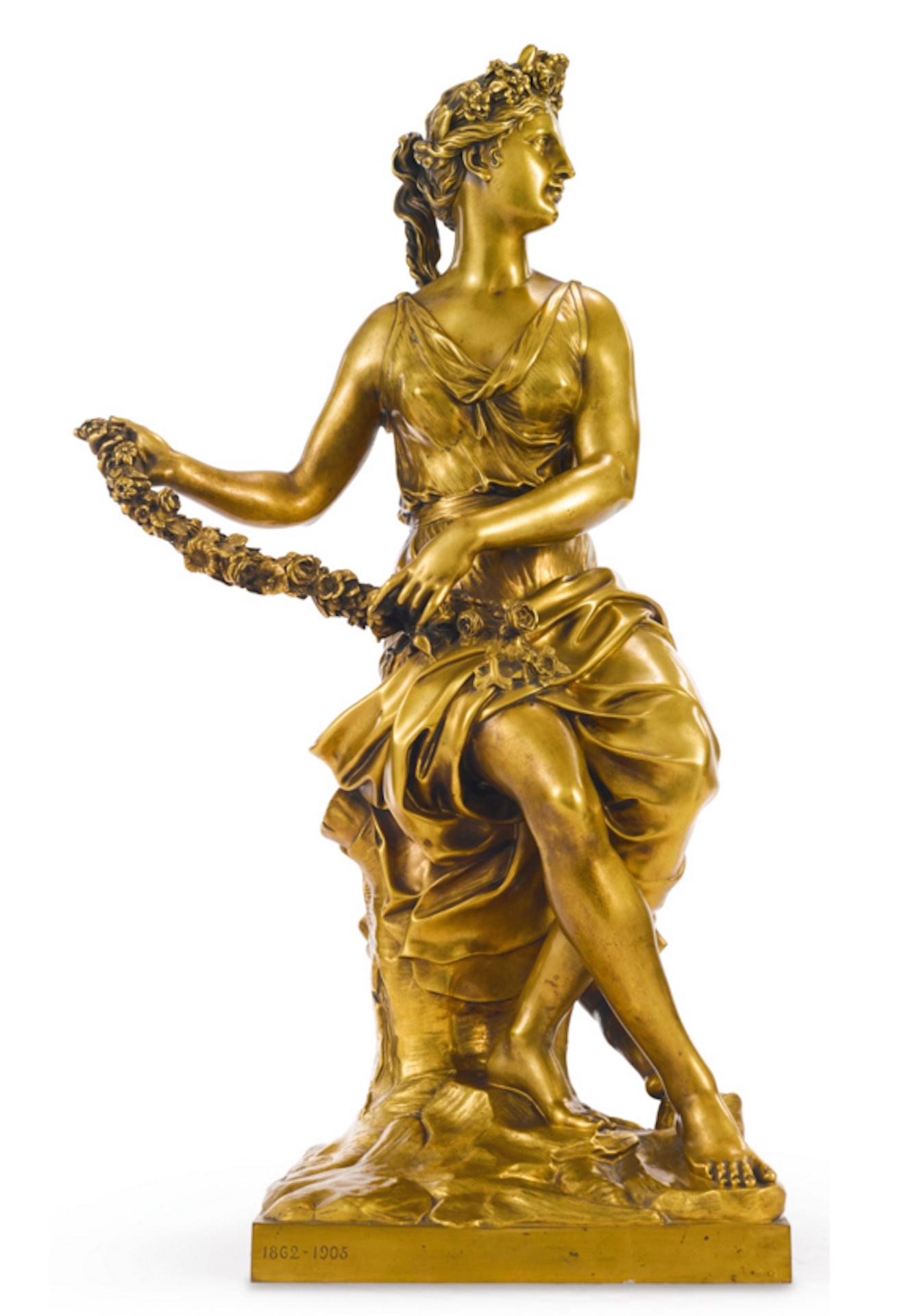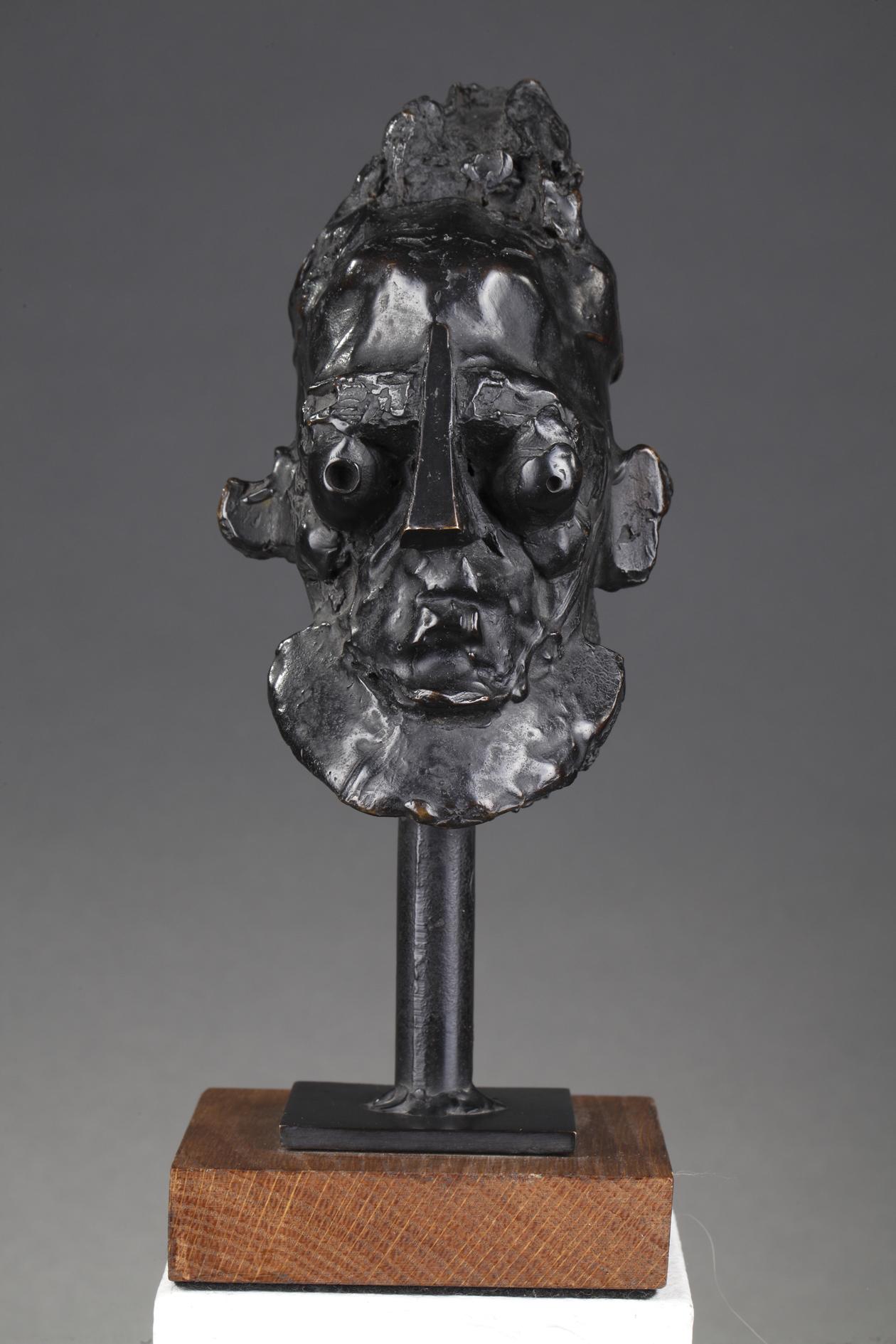Items Similar to Dominique Mahlknecht (1793-1876) The french philosopher René Descartes
Want more images or videos?
Request additional images or videos from the seller
1 of 9
Dominique MahlknechtDominique Mahlknecht (1793-1876) The french philosopher René Descartes1842
1842
About the Item
Dominique (Johann Dominik) MAHLKNECHT
(Kastelruth, 1793 - Paris, 1876)
Full length portrait of René Descartes
Terracotta with brown patina
Height: 40cm
Signed and dated on the base
1844
A native of South Tyrol (now northern Italy), Mahlknecht is sometimes erroneously described as a pupil of Canova, but it seems that he himself claimed to have received lessons from the neo-classical sculptor. After short stays in Lyon and then in Le Mans, the still Austrian young artist settled in Nantes in 1812, where he worked in the studio of Joseph Debay (1779-1863); the city appointed him municipal sculptor in 1821. It was on the occasion of the inauguration of its monumental sculpture of Louis XVI, in September 1823, that Mahlknecht met the Duchess of Angoulême, with whom he would be familiar from then on. A legitimist artist, several of his sculptures thus represent Bourbons (Louis XVI, the Duke of Bordeaux), or Vendée figures (Charette, Cathelineau); he was designated on September 4, 1826 "Sculptor of his Royal Highness", and the State granted him a workshop at 9, quai d'Orsay in Paris, where he had arrived in 1825.
Under the July Monarchy, Mahlknecht retained the favors of the new royal power, which commissioned many religious-themed works from him, among other things, to decorate churches (the Invalides, the Madeleine, Saint-Germain l'Auxerrois, the church of Saint- Louis of Versailles, for example); in 1831 he also created a bust of Louis-Philippe, and received a medal at the Salon of the same year for his Venus in marble, assigned to Orléans. Austrian turned Nantes, Mahlknecht was naturalized French in 1848 (or perhaps 1846), and was made a Knight of the Legion of Honor.
Alongside his religious and sometimes mythological production (Adonis, Ulysses, Terpsichore...), Mahlknecht is also the sculptor of French glories, subjects that correspond well to this period when Louis-Philippe wishes to rehabilitate the History of France; for example, he produced effigies of Du Guesclin, Saint Vincent de Paul, Molière, Corneille, Duguay-Trouin, Parmentier. More specifically in 1844, the year of our statuette, he created the statues of Murat, Marshal Bessières and Dumont d'Urville.
Our representation of René Descartes corresponds in all likelihood to a preparatory sketch (commission or "spontaneous" proposal by Mahlknecht) for a project that was not carried out; the case was frequent for sculptors, and Mahlknecht had known about it for an order from the city of Rennes for a statue of Louis XVI in 1827.
Sculpted effigies of Descartes were rare until then, apart from the work of Pajou in 1777, and a bust in cast iron presented at the Salon de Douai in 1828 by the founder Lepet-Desuede. Emilien Nieuwerkerke (1811-1892) created a full-length statue in 1846 for the city of Tours; as in Mahlknecht's version, to which it is ultimately quite close, there is a pile of books at the feet of the philosopher and mathematician, but with a sphere instead of a compass.
Guillaume Bonnet (1820-1873) presented a plaster bust at the Salon of 1849, commissioned by the Ministry of the Interior. Interestingly enough, the Nantes sculptor Jean-Baptiste Barré (1804-1877), a pupil of Mahlknecht, presented at the Salon of 1866 a plaster statue (full length) of Descartes, which was kept in the Rennes museum, but has now been lost; perhaps this work was inspired by the statuette of his master?
- Creator:Dominique Mahlknecht (1793 - 1876, French)
- Creation Year:1842
- Dimensions:Height: 15.75 in (40 cm)Width: 5.52 in (14 cm)
- Medium:
- Movement & Style:
- Period:
- Condition:
- Gallery Location:BELEYMAS, FR
- Reference Number:1stDibs: LU1860210122462
About the Seller
No Reviews Yet
Vetted Seller
These experienced sellers undergo a comprehensive evaluation by our team of in-house experts.
Established in 2011
1stDibs seller since 2022
- ShippingRetrieving quote...Ships From: BELEYMAS, France
- Return PolicyThis item cannot be returned.
More From This SellerView All
- General Cambronne bust in "Hermès" - Att. to E-E Suc (1802-1855)Located in BELEYMAS, FRAttributed to Etienne-Édouard SUC (Lorient, 1802 – Nantes, 1855) Bust "in Hermès" of General Cambronne Plaster H. 59 cm 1842 Provenance: probably Madame Cambronne (1773-1854), widow...Category
1840s French School Figurative Sculptures
MaterialsPlaster
- Charles Merme (1818-1869) The blessing of Coureau de Groix in Larmor BrittanyLocated in BELEYMAS, FRCharles MERMÉ (Cherbourg 1818 - Lorient 1869) The blessing of Coureau de Groix at Larmor Oil on canvas H. 60 cm; W. 100 cm Signed and dated lower left, 1...Category
1860s French School Figurative Paintings
MaterialsCanvas, Oil
- French King Louis-Philippe - After Baron GérardLocated in BELEYMAS, FRAfter Baron Gérard, circa 1835 Portrait of King Louis-Philippe Oil on canvas H. 79 cm; L. 65 cm Provenance : Private collection, Périgord, by descent since the 19th century This po...Category
1830s French School Figurative Paintings
MaterialsCanvas, Oil
- Maurice Lobre (1862 -1951) The snackBy Maurice LobreLocated in BELEYMAS, FRMaurice LOBRE (Bordeaux 1862 - Paris 1951) Le goûter Huile sur toile H. 87 cm ; L. 91,5 cm Format peint d’origine, H. 101 cm ; L. 96 cm, disposé sur un châssis plus petit par l’artiste lui-même. Signée et datée 1888 en bas à droite Provenance : Collection privée, Lyon Exposition : 1889, Salon des Artistes Français, n°1719 « Intérieur », (ou 1720 nommé également « Intérieur ») Œuvres en rapport : Le Cabinet de toilette de Jacques-Emile Blanche, (titre erroné) H. 80 cm ; L. 85 cm, HST, Museo Thyssen-Bornemisza, Madrid, pendant de notre toile. Maurice Lobre a-t-il connu Marcel Proust ? On ne peut encore l'affirmer, bien qu'il ait eu de nombreux amis en commun avec l'écrivain. Mais sa peinture intimiste pourrait illustrer certaines pages de Du côté de chez Swann. Trois citations dues à des proches de Proust, l'une de l'écrivain Léon Daudet, la seconde du peintre Jacques-Emile Blanche, la dernière du poète mondain Robert de Montesquiou, donnent un aperçu de ce que fut la renommée de Maurice Lobre en son temps : "Il en va autrement de Lobre, le Vermeer français, le peintre exquis des intérieurs et des palais de Versailles, des reflets sur les meubles rares, de la lumière prisonnière des miroirs, des laques et des cuivres polis. Lobre est joyeux comme un coup de vent, qui fait envoler les préjugés et les poncifs, éloquent, passionné, ivre de la couleur et des formes, charmant et conquérant de toutes les matières. Il se promène ici-bas ainsi que dans un musée en plein-air, s'amuse de tout, rejette et maudit le laid et le vil, accueille et bénit le beau et le bien…" Léon Daudet L'Entre-deux-guerres. Souvenirs des milieux littéraires, politiques, artistiques et médicaux de 1880 à 1905. "Voici le patient, appliqué, sage M. Lobre. Il est difficile de mettre plus d'honnêteté à peindre des intérieurs sans figures. Je préfère ses petits salons de Versailles à ses cathédrales… Nous lui devons des petits bijoux d'émotion et de large fini." Jacques-Emile Blanche "Il a recueilli sur des toiles le visage du vieux Versailles (…). Il a peuplé de visions impalpables des chambres " où il s'est passé quelque chose ", et il en a saturé l'atmosphère de particules historiques. Donner une telle impression avec certitude, avec vérité, c'est plus difficile que de faire évoluer des personnages costumés, dans ce qu'on appelle bêtement "une reconstitution historique"." Comte Robert de Montesquiou Maurice Lobre commence sa carrière au Salon de 1882 où il expose deux portraits, dont celui de son camarade de l'atelier Carolus-Duran, le peintre espagnol Ramon Casas...Category
1880s French School Figurative Paintings
MaterialsCanvas, Oil
- François-Joseph Kinson - Young woman portrait with her dogBy Francois Kinsoen (Kinson)Located in BELEYMAS, FRFrançois-Joseph KINSON (Bruges 1770 – Bruges 1839) Portrait of a young woman near a spring, accompanied by her dog Oil on canvas H. 73 cm; L. 60 cm circa 1815-1817 We owe this elegant portrait to François-Joseph Kinson from Bruges, which is still linked to the art of the First Empire. We find in this artist this type of pose that is a bit rigid, sometimes with a countryside in the background, and this way of treating costumes and faces. Thus the full-length portrait of Jenny...Category
1810s French School Figurative Paintings
MaterialsCanvas, Oil
- French school c.1815 - Portrait of a young boyLocated in BELEYMAS, FRFrench school circa 1815 Portrait of a young boy Oil on canvas H. 84 cm; L. 70 cm Provenance: Señor Valdes Fauri Collection, Madrid around 1900/1950; then Private collection, Bordea...Category
1810s French School Figurative Paintings
MaterialsCanvas, Oil
You May Also Like
- Friendship, comfort: hand modelled sculpture by Polish Jewish French artistLocated in Norwich, GBAn extraordinary depiction of friendship and comfort by Polish Jewish sculptor Michal Michael Milberger. Milberger was born in Warsaw in 1922. His artis...Category
Late 20th Century French School Figurative Sculptures
MaterialsPlaster
- Flora et L'amour ou HamadryadeBy Ferdinand BarbedienneLocated in Tallinn, EEFerdinand Barbedienne (1810 - 1892) Antoine Coysevox, after (France, 1640-1720) Flora et L'amour ou Hamadryade Inscribed 'A. COYSEVOX. F. 1710'. With foundry mark 'F. BARBEDIENNE...Category
Late 19th Century French School Figurative Sculptures
MaterialsBronze
- Lion and snakeBy Antoine-Louis BaryeLocated in PARIS, FRLion and snake n°3 by Antoine-Louis Barye (1796-1875) Bronze sculpture with a nuanced dark greenish brown patina signed "Barye" on the base old edition cast – probably from the Bary...Category
1860s French School Figurative Sculptures
MaterialsBronze
- The SpringBy Albert-Ernest Carrier-BelleuseLocated in PARIS, FRThe Spring by Albert-Ernest CARRIER-BELLEUSE (1824-1887) Sculpture made in white Carrara marble signed on the base "A. Carrier-Belleuse" France circa 1870 height 76,5 cm width 30 cm depth 24 cm Biography : Albert-Ernest Carrier de Belleuse known as Carrier-Belleuse (1824-1887) was one of the most prolific artists of the century and had the greatest successes under the Second Empire, enjoying the personal support of Napoleon III. His work was greatly influenced by the style of the Italian Renaissance and that of the 18th century, which he helped to bring up to date. In 1837, the young Carrier-Belleuse apprenticed in the workshop of the engraver Bauchery. He was admitted soon after to the goldsmith Jacques Henri Fauconnier. Through François Arago, he met the sculptor David d'Angers who facilitated his admission to the School of Fine Arts. Carrier-Belleuse entered it in 1840. Noted for his skill by the great bronze companies in Paris such as Barbedienne and Denière, he soon received numerous orders for models for candelabras, pendulums, fittings for fireplaces, etc. In 1848, probably at the initiative of François Arago, who became head of state, he received his first public order for a small statue of "Mademoiselle Rachel singing La Marseillaise". In 1851, he appeared for the first time at the Salon of French Artists, where he presented two bronze medallions. From 1851 to 1855, Carrier-Belleuse stayed in England, in Stoke-on-Trent where he served as director of the modeling and drawing school of the Minton house, a large porcelain manufacturer. Back in France, Carrier-Belleuse moved to Paris in a large workshop located 15 rue de la Tour d´Auvergne. From 1857, he made regular sendings to the Salon and became famous thanks to the success of large marbles, such as the "Bacchante" exhibited at the Salon in 1863, and acquired by Napoleon III, "Angelica" (1866) or even "Hebe asleep" (1869). At the Salon of 1867, his group entitled "Messiah" earned him the medal of honor of sculpture. It was acquired by the State to adorn the Chapel of the Virgin in the Saint-Vincent-de-Paul church. Carrier-Belleuse acquired a great reputation in parallel for his terracotta busts which, in many respects, recall those of 18th century artists. He made portraits of a large number of celebrities of his time. He produced, among others, the busts of Napoleon III, Renan, Thiers, Grévy, Arago, Marguerite Bellanger, Théophile Gautier, Honoré Daumier, Delacroix, Hortense Schneider, Réjane… He also modelled numerous busts of mythological inspiration and historical and artistic portraits like Marie Stuart, Shakespeare or even Mozart. Carrier-Belleuse used and trained in his workshop in the rue de la Tour d´Auvergne many young talented artists such as Alexandre Falguière, Jules Desbois, Eugène Delaplanche, Jules Dalou or Joseph Chéret; but he was best known for having been the master of Auguste Rodin who entered his studio as a practitioner in 1864. Carrier-Belleuse devoted himself a lot to decorative sculpture. He contributed to the decorations of many important buildings. We owe him in particular the caryatids of the Renaissance theater in Paris, the pediment of the main entrance to the Banque de France, the stucco ceilings of the Lesdiguières and La Trémoïlle pavilions at the Louvre Palace, the frieze of the Palais de la Bourse in Brussels, or the decoration of the Hôtel de la Païva on the Champs-Elysées in Paris. He also received State commissions for monuments: that of Jean-Jacques Rousseau in Montmorency, of Alexandre Dumas, in Villers-Cotterêts, of Masséna in Nice. Abroad, he produced the equestrian statue of Michael the brave in Bucharest and the tomb of José de San Martín in Buenos Aires. In 1873, Carrier-Belleuse took part in the construction of the Paris Opera house, directed by his friend Charles Garnier. He created the two monumental torchieres...Category
1870s French School Figurative Sculptures
MaterialsMarble
- Man's headLocated in PARIS, FRLaurent Belloni (né En 1969) Man's head Bronze cast with a nuanced black patina Signed "Belloni" on the foot Foundry mark "Susse fondeur Paris" numbered 1/8 France around 1996 hei...Category
1990s French School Figurative Sculptures
MaterialsBronze
- PheasantBy François PomponLocated in PARIS, FRPheasant by François Pompon (1855-1933) Exceptional bronze with old gilded patina Cast by Valsuani Period cast France circa 1930 height 8,2 cm length 14,2 cm width 3,6 cm A simila...Category
1930s French School Figurative Sculptures
MaterialsBronze
Recently Viewed
View AllMore Ways To Browse
Antique French Medals
Antique French Medal
Dominique France
French Classical Figurative
French Classical School
Tour D France
French Germain
Effigy Art
Dominique Brown
Antique Plaster Busts
Antique Plaster Bust
Antique School Books
French Cast Iron Sculpture
Effigy Sculpture
Rene Louis
Antique Religious Statue
Antique Religious Statues
Antique Saint Statues



